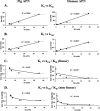Aminopeptidase fingerprints, an integrated approach for identification of good substrates and optimal inhibitors
- PMID: 19948737
- PMCID: PMC2823418
- DOI: 10.1074/jbc.M109.060418
Aminopeptidase fingerprints, an integrated approach for identification of good substrates and optimal inhibitors
Abstract
Aminopeptidases process the N-terminal amino acids of target substrates by sequential cleavage of one residue at a time. They are found in all cell compartments of prokaryotes and eukaryotes, being implicated in the major proteolytic events of cell survival, defense, growth, and development. We present a new approach for the fast and reliable evaluation of the substrate specificity of individual aminopeptidases. Using solid phase chemistry with the 7-amino-4-carbamoylmethylcoumarin fluorophore, we have synthesized a library of 61 individual natural and unnatural amino acids substrates, chosen to cover a broad spectrum of the possible interactions in the S1 pocket of this type of protease. As proof of concept, we determined the substrate specificity of human, pig, and rat orthologs of aminopeptidase N (CD13), a highly conserved cell surface protease that inactivates enkephalins and other bioactive peptides. Our data reveal a large and hydrophobic character for the S1 pocket of aminopeptidase N that is conserved with aminopeptidase Ns. Our approach, which can be applied in principle to all aminopeptidases, yields useful information for the design of specific inhibitors, and more importantly, reveals a relationship between the kinetics of substrate hydrolysis and the kinetics of enzyme inhibition.
Figures






Similar articles
-
An integrated approach to the ligand binding specificity of Neisseria meningitidis M1 alanine aminopeptidase by fluorogenic substrate profiling, inhibitory studies and molecular modeling.Biochimie. 2013 Feb;95(2):419-28. doi: 10.1016/j.biochi.2012.10.018. Epub 2012 Nov 3. Biochimie. 2013. PMID: 23131591 Free PMC article.
-
S1 pocket fingerprints of human and bacterial methionine aminopeptidases determined using fluorogenic libraries of substrates and phosphorus based inhibitors.Biochimie. 2012 Mar;94(3):704-10. doi: 10.1016/j.biochi.2011.10.014. Epub 2011 Nov 7. Biochimie. 2012. PMID: 22085501
-
Discovery, Structural and Biochemical Studies of a rare Glu/Asp Specific M1 Class Aminopeptidase from Legionella pneumophila.Int J Biol Macromol. 2018 Dec;120(Pt A):1111-1118. doi: 10.1016/j.ijbiomac.2018.08.172. Epub 2018 Aug 30. Int J Biol Macromol. 2018. PMID: 30172821
-
The characteristics, functions and inhibitors of three aminopeptidases belonging to the m1 family.Curr Protein Pept Sci. 2012 Aug;13(5):490-500. doi: 10.2174/138920312802430554. Curr Protein Pept Sci. 2012. PMID: 22954453 Review.
-
Progress in the development of aminopeptidase N (APN/CD13) inhibitors.Curr Med Chem Anticancer Agents. 2005 May;5(3):281-301. doi: 10.2174/1568011053765949. Curr Med Chem Anticancer Agents. 2005. PMID: 15992355 Review.
Cited by
-
The Staphylococcus aureus leucine aminopeptidase is localized to the bacterial cytosol and demonstrates a broad substrate range that extends beyond leucine.Biol Chem. 2013 Jun;394(6):791-803. doi: 10.1515/hsz-2012-0308. Biol Chem. 2013. PMID: 23241672 Free PMC article.
-
A naturally variable residue in the S1 subsite of M1 family aminopeptidases modulates catalytic properties and promotes functional specialization.J Biol Chem. 2013 Sep 6;288(36):26004-26012. doi: 10.1074/jbc.M113.465625. Epub 2013 Jul 29. J Biol Chem. 2013. PMID: 23897806 Free PMC article.
-
A remarkable activity of human leukotriene A4 hydrolase (LTA4H) toward unnatural amino acids.Amino Acids. 2014 May;46(5):1313-20. doi: 10.1007/s00726-014-1694-2. Epub 2014 Feb 27. Amino Acids. 2014. PMID: 24573245 Free PMC article.
-
Metallo-aminopeptidase inhibitors.Biochimie. 2010 Nov;92(11):1509-29. doi: 10.1016/j.biochi.2010.04.026. Epub 2010 May 10. Biochimie. 2010. PMID: 20457213 Free PMC article. Review.
-
Probing the S1 specificity pocket of the aminopeptidases that generate antigenic peptides.Biochem J. 2011 Apr 15;435(2):411-20. doi: 10.1042/BJ20102049. Biochem J. 2011. PMID: 21314638 Free PMC article.
References
Publication types
MeSH terms
Substances
Grants and funding
LinkOut - more resources
Full Text Sources
Research Materials
Miscellaneous

